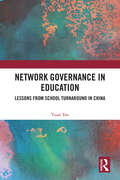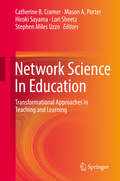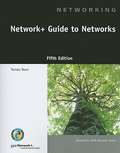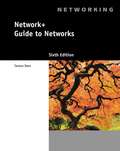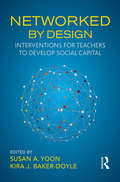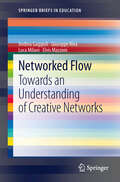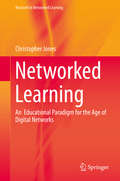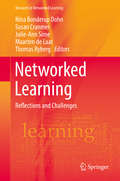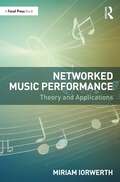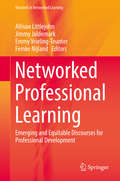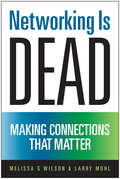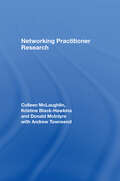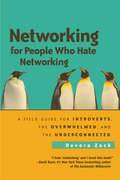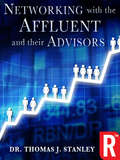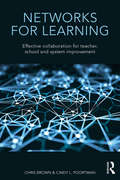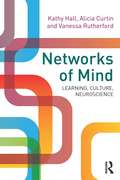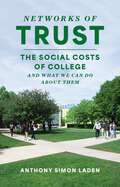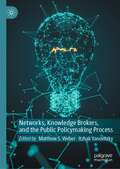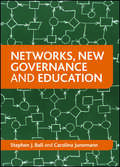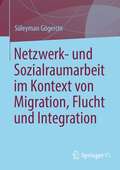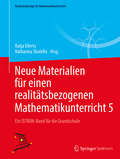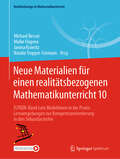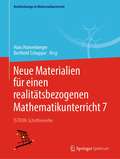- Table View
- List View
Network Governance in Education: Lessons from School Turnaround in China
by Yuan TaoThis book explores and theorizes the complexity of network governance in school turnaround in China, drawing on an interpretive qualitative paradigm.School turnaround provides a useful perspective for understanding network governance in education, as it involves interactions among multiple parties of actors all aiming to improve school quality. Based on a case study of three school turnaround networks in Shanghai, this book analyzes the complexity of interactions among schools, local governments, and third-party actors. The study goes beyond a simple description of the plurality of state and non-state actors involved in education. It places particular emphasis on the power of network actors and the power dynamics among them that shape their interactions and positions in educational governance. The power perspective adopted in this book provides insight into which network actors matter in education governance and how network governance should be applied in education, particularly in school turnaround.The book will appeal to scholars and students of education and will be particularly useful to policymakers and practitioners interested in educational administration, management and leadership, educational improvement, and Chinese education.
Network Science In Education: Transformational Approaches in Teaching and Learning
by Mason A. Porter Hiroki Sayama Catherine B. Cramer Lori Sheetz Stephen Miles UzzoAround the globe, there is an increasingly urgent need to provide opportunities for learners to embrace complexity; to develop the many skills and habits of mind that are relevant to today's complex and interconnected world; and to make learning more connected to our rapidly changing workplace and society. This presents an opportunity to (1) leverage new paradigms for understanding the structure and function of teaching and learning communities, and (2) to promote new approaches to developing methods, curricular materials, and resources. Network science - the study of connectivity - can play an important role in these activities, both as an important subject in teaching and learning and as a way to develop interconnected curricula. Since 2010, an international community of network science researchers and educators has come together to raise the global level of network literacy by applying ideas from network science to teaching and learning. Network Science in Education - which refers to both this community and to its activities - has evolved in response to the escalating activity in the field of network science and the need for people to be able to access the field through education channels. Network Science In Education: Transformational Approaches in Teaching and Learning appeals to both instructors and professionals, while offering case studies from a wide variety of activities that have been developed around the globe: the creation of entirely new courses and degree programs; tools for K-20 learners, teachers, and the general public; and in-depth analysis of selected programs. As network-based pedagogy and the community of practice continues to grow, we hope that the book's readers will join this vibrant network education community to build on these nascent ideas and help deepen the understanding of networks for all learners.
Network Science, A Decade Later: The Internet and Classroom Learning
by Alan Feldman Cliff Konold Bob Coulter Brian ConroyNetwork Science, A Decade Later--the result of NSF-funded research that looked at the experiences of a set of science projects which use the Internet--offers an understanding of how the Internet can be used effectively by science teachers and students to support inquiry-based teaching and learning. The book emphasizes theoretical and critical perspectives and is intended to raise questions about the goals of education and the ways that technology helps reach those goals and ways that it cannot. The theoretical perspective of inquiry-based teaching and learning in which the book is grounded is consistent with the current discipline-based curriculum standards and frameworks. The chapters in Part I, "State of the Art," describe the history and current practice of network science. Those in Part II, "Looking Deeply," extend the inquiry into network science by examining discourse and data in depth, using both empirical data and theoretical perspectives. In Part III, "Looking Forward," the authors step back from the issues of network science to take a broader view, focusing on the question: How should the Internet be used--and not used--to support student learning? The book concludes with a reminder that technology will not replace teachers. Rather, the power of new technologies to give students both an overwhelming access to resources--experts, peers, teachers, texts, images, and data--and the opportunity to pursue questions of their own design, increases the need for highly skilled teachers and forward-looking administrators. This is a book for them, and for all educators, policymakers, students involved in science and technology education. For more information about the authors, an archived discussions space, a few chapters that can be downloaded as PDF files, and ordering information, visit teaparty.terc.edu/book/
Network+ Guide to Networks (5th edition)
by Tamara DeanThis book introduces the fundamental building blocks that form a modern network, such as protocols, topologies, hardware, and network operating systems. It then provides in-depth coverage of the most important concepts in contemporary networking, such as TCP/IP, Ethernet, wireless transmission, and security.
Network+ Guide to Networks 6th Edition
by Tamara DeanThe completely updated NETWORK+ GUIDE TO NETWORKS, 6th Edition gives readers the technical skills and industry know-how required to begin an exciting career installing, configuring, and troubleshooting computer networks. The text also prepares readers for CompTIA's Network+ N10-005 certification exam with fundamentals in protocols, topologies, hardware, and network design. After exploring TCP/IP, Ethernet, wireless transmission, and security concepts, as well as an all-new chapter on virtual networks, readers can increase their knowledge with the practical "On-the Job" stories, Review Questions, Hands-On Projects, and Case Projects
Networked By Design: Interventions for Teachers to Develop Social Capital
by Susan A. Yoon Kira J. Baker-DoyleNetworked by Design brings together work from leading international scholars in the learning sciences that applies social network theory to teachers’ social interactions and relationships. The volume examines the direct and indirect relationships and communities that teachers navigate, as well as the models, plans, and other interventions that allow them to exercise control over these networks. Each chapter draws from case studies or latitudinal research to investigate a different intervention and its outcomes. By presenting research conducted in a variety of scales and contexts, this book offers scholars, future teachers, and leaders diverse insights into how interventions in social capital and social networks can create impactful, meaningful teaching and learning.
Networked Flow
by Luca Milani Giuseppe Riva Elvis Mazzoni Andrea GaggioliIdentifying 'networked flow' as the key driver of networked creativity, this new volume in the Springer Briefs series deploys concepts from a range of sub-disciplines in psychology to suggest ways of optimizing the innovative potential of creative networks. In their analysis of how to support these networks, the contributing authors apply expertise in experimental, social, cultural and educational psychology. They show how developing a creative network requires the establishment of an optimal group experience in which individual intentions inform and guide collective goals. The volume represents a three-fold achievement. It develops a ground-breaking new perspective on group creativity: the notion of 'networked flow' as a bridging concept linking the neuropsychological, psychological and social levels of the creative process. In addition, the authors set out a six-stage model that provides researchers with a methodological framework (also by referring to the social network analysis) for studying the creativity traditionally associated with interpersonal contexts. Finally, the book includes perceptive analysis of the novel possibilities opened up by second-generation internet technologies, particularly in social networking, that seem destined to develop and sustain online creativity. As a wide-ranging exposition of a new direction in theoretical psychology that is laden with exciting possibilities, this volume will inform and inspire professionals, scholars and students alike.
Networked Learning
by Christopher JonesThis book posits the idea that networked learning is the one new paradigm in learning theory that has resulted from the introduction of digital and networked technologies It sets out, in a single volume, a critical review of the main ideas and then articulates the case for adopting a networked learning perspective in a variety of educational settings. This book fills a gap in the literature on networked learning Although there are several edited volumes in the field there is no other monograph makes the academic case and provides the academic context for networked learning. This volume accomplishes three main goals. First, it assists researchers and practitioners in acquainting themselves with the field. Second, it provides resources for reference and guidance to those not well acquainted with the field Finally and most powerfully, it also allows for the consolidation of a field that is truly multidisciplinary in a way that maintains coherence and consistency.
Networked Learning: Reflections And Challenges (Research in Networked Learning)
by Thomas Ryberg Maarten De Laat Nina Bonderup Dohn Susan Cranmer Julie-Ann SimeThe book is based on nine selected, peer-reviewed papers presented at the 10th biennial Networked Learning Conference (NLC) 2016 held in Lancaster. Informed by suggestions from delegates, the nine papers have been chosen by the editors (who were the Chairs of the Conference) as exemplars of cutting edge research on networked learning. Further reviews of all papers were conducted once they were revised as chapters for the book. The chapters are organized into two sections: 1) Situating Networked Learning: Looking Back - Moving Forward, 2) New Challenges: Designs for Networked Learning in the Public Arena. Further, we include an introduction which looks at the evolution of trends in Networked Learning through a semantic analysis of conference papers from the 10 conferences. A final chapter draws out perspectives from the chapters and discusses emerging issues. The book is the fifth in the Networked Learning Conference Series.
Networked Music Performance: Theory and Applications
by Miriam IorwerthNetworked Music Performance (NMP) is the essential guide to both playing music online and ensemble music through networks. Offering a range of case studies, from highly technical solutions to inclusive community projects, this book provides inspiration to musicians to try NMP whatever their level of technical expertise. Drawing upon recent research to examine the background and history of the practice as well as specific practical approaches, technical and musical considerations are included for readers, as are ideas around accessibility and creativity. Accessibility is considered in the context of the opportunities that NMP gives to musicians working remotely, as well as some of the barriers to participation in NMP and how these can be overcome. Synchronous and asynchronous approaches to NMP are explored in detail, examining the technical and musical affordances and challenges of working remotely for musicians. Networked Music Performance will appeal to music and music technology students as well as professional musicians and technicians who have started working online and wish to improve their practice. As NMP in the context of music education and community music are also explored, this book supplies educators and community leaders with knowledge and practical guidance on how to move their practice online.
Networked Professional Learning: Emerging and Equitable Discourses for Professional Development (Research in Networked Learning)
by Allison Littlejohn Jimmy Jaldemark Emmy Vrieling-Teunter Femke NijlandOver the past decades a new form of professionalism has emerged, characterized by factors of fluidity, instability and continual change, leading to the necessitation of new forms of professional development that support agile and flexible expansion of professional practice. At the same time, the digitization of work has had a profound effect on professional practice. This digitization opens up opportunities for new forms of professional learning mediated by technologies through networked learning. Networked learning is believed to lead to a more efficient flow of complex knowledge and routine information within the organization, stimulate innovative behaviour, and result in a higher job satisfaction. In this respect, networked learning can be perceived as an important perspective on both professional and organizational development. This volume provides examples of Networked Professional Learning, it questions the impact of this emerging form of learning on the academy, and it interrogates the impact on teachers of the future. It features three sections that explore networked professional learning from different perspectives: questioning what legitimate forms of networked professional learning are across a broad sampling of professions, how new forms of professional learning impact institutions of higher education, and the value creation that Networked Learning offers professionals in broader educational, economic, and social contexts. The book is of interest to researchers in the area of professional and digital learning, higher education managers, organizational HR professionals, policy makers and students of technology enhanced learning.
Networking Is Dead: Making Connections That Matter
by Melissa G Wilson Larry MohlAre you... hoping your next networking event will be "the one"?... collecting mountains of business cards?... having countless breakfasts and lunches?... thinking about what you give and get?Then your way of networking is ... dead.With social networks, teleconferencing, and webinars, you are able to meet more people in more ways than ever before. But that doesn't mean you're creating new possibilities through valuable connections.Networking Is Dead offers a new approach to fundamental networking misconceptions. Authors Melissa G Wilson and Larry Mohl show it's the quality rather than the quantity of connections that counts. Their fable tells the story of connection expert Dan guiding Meredith, an outgoing social media expert, and Lance, a shy accountant, to build relationships that matter to them and their businesses. It shows an effective process that lets you: Deepen existing relationships and make meaningful new ones Connect across your own company to strengthen your business Find people with similar values to embark on mutually beneficial opportunities Leverage your connections instead of being overwhelmed by themNetworking Is Dead is an engaging story that provides easy-to-implement tips at the end of each chapter. This powerful combination of story and time-tested action steps provides a comprehensive roadmap to achieve even your toughest goals.Networking is dead, but making connections that matter will bring new possibilities to life for you and your organization.
Networking Practitioner Research
by Andrew Townsend Kristine Black-Hawkins Donald McIntyre Colleen McLaughlinA complement to Researching Schools by the same authors, this book provides readers with a strong theoretical framework for school-based research as well as valuable advice on the ways in which networks of specialist groups can work together to create a broad-ranging approach to educational research. Through a critical examination of existing research and current thinking, the authors draw out implications for the effective policy and practice of school-based research. Illustrated throughout with case studies and including a full and detailed literature review, this book will be a vital resource for all academics pursuing research into education.
Networking for People Who Hate Networking: A Field Guide for Introverts, the Overwhelmed, and the Underconnected
by Devora ZackShows how the networking-averse can succeed by working with the very traits that make them hate traditional networking Written by a proud introvert who is also an enthusiastic networker Includes field-tested tips and techniques for virtually any situation Are you the kind of person who would rather get a root canal than face a group of strangers? Does the phrase “working a room” make you want to retreat to yours? Does traditional networking advice seem like it’s in a foreign language? Devora Zack, an avowed introvert and a successful consultant who speaks to thousands of people every year, feels your pain. She found that most networking advice books assume that to succeed you have to become an outgoing, extraverted person. Or at least learn how to fake it. Not at all. There is another way. This book shatters stereotypes about people who dislike networking. They’re not shy or misanthropic. Rather, they tend to be reflective—they think before they talk. They focus intensely on a few things rather than broadly on a lot of things. And they need time alone to recharge. Because they’ve been told networking is all about small talk, big numbers and constant contact, they assume it’s not for them. But it is! Zack politely examines and then smashes to tiny fragments the “dusty old rules” of standard networking advice. She shows how the very traits that ordinarily make people networking-averse can be harnessed to forge an approach that is just as effective as more traditional approaches, if not better. And she applies it to all kinds of situations, not just formal networking events. After all, as she says, life is just one big networking opportunity—a notion readers can now embrace. Networking enables you to accomplish the things that are important to you. But you can’t adopt a style that goes against who you are—and you don’t have to. “I have never met a person who did not benefit tremendously from learning how to network—on his or her own terms”, Zack writes. “You do not succeed by denying your natural temperament; you succeed by working with your strengths.”
Networking with the Affluent and their Advisors
by Dr. Thomas J. StanleyThe New York Times bestselling author of The Millionaire Next Door reveals the secrets and strategies for building a network of wealthy clients. In Networking with the Affluent, business theorist Thomas J. Stanley shares effective tactics for developing relationships with wealthy individuals—as well as their advisors—and generating new business among this highly exclusive target market. Dr. Stanley provides a proven road map for building trust, securing interest, and forging profitable relationships with wealthy audiences—including tactics for boosting your credibility and assuring continued loyalty among wealthy customers. Networking with the Affluent covers: Cracking affluent groupsInfluencing opinion leaders of the affluentGaining high-caliber endorsementsLeveraging your contacts &“No one better illuminates the who, where, and how of the affluent market than Tom Stanley.&”—J. Arthur Urciuoli, Director of Marketing, Merrill Lynch
Networks for Learning: Effective Collaboration for Teacher, School and System Improvement
by Chris Brown Cindy L. PoortmanEducational researchers, policy-makers and practitioners are increasingly focusing their attention on Professional Learning Networks in order to facilitate teacher development and encourage school and school system improvement. However, despite the understanding that PLNs can contribute significantly to improving teaching practice and student achievement, there are key challenges regarding their use. These challenges include: ensuring PLNs can provide opportunities for generating and sharing knowledge within schools enabling teachers and professionals to direct their own development helping individuals change their practices through inquiry-led approaches facilitating partnerships which work across a variety of stakeholders In this new edited volume, Brown and Poortman evaluate these challenges from both a theoretical and practical approach. A multitude of perspectives from a team of international contributors covers: the importance of Professional Learning Networks the use of evidence within PLNs the impact of inter-school networks international cases of networks and communities the promotion and sustainability of PLNs Also featuring case studies and exemplars to contextualise sustainable learning networks, Networks For Learning is an accessible and thoroughly-researched book, which will be essential reading and a valuable resource for researchers, teachers and school leaders who are interested in developing professional learning networks.
Networks of Mind: Learning, Culture, Neuroscience
by Kathy Hall Alicia Curtin Vanessa RutherfordThis ground breaking book is unique in bringing together two perspectives on learning - sociocultural theory and neuroscience. Drawing on both perspectives, it foregrounds important developments in our understanding of what learning is, where and how learning occurs and what we can do to understand learning as an everyday process. Leading experts from both disciplines demonstrate how sociocultural ideas (such as the relevance of experience, opportunity to learn, environment, personal histories, meaning, participation, memory, and feelings of belonging) align with and reflect upon new understandings emerging from neuroscience concerning plasticity and neural networks. Among the themes critically examined are the following: Mind and brain Culture Ability and talent Success and failure Memory Language Emotion Aimed at and accessible to a broad audience and drawing on both schools of thought, Networks of Mind employs case studies, vignettes and real life examples to demonstrate that, though the language of sociocultural theory and that of neuroscience appear very different, ultimately the concepts of both perspectives align and converge around some key ideas. The book shows where both perspectives overlap, collide and diverge in their assumptions and understanding of fundamental aspects of human flourishing. It shows how neuroscience confirms some of the key messages already well established by sociocultural theory, specifically the importance of opportunity to learn. It also argues that the ascendency of neuroscience may result in the marginalization of sociocultural science, though the latter, it argues, has enormous explanatory power for understanding and promoting learning, and for understanding how learning is afforded and constrained.
Networks of Trust: The Social Costs of College and What We Can Do about Them
by Anthony Simon LadenAn eye-opening look at how parents’ mistrust of colleges has less to do with what their kids are learning than with whom they come to trust. Higher education is a familiar battlefield in today’s culture wars. The right accuses colleges and universities of indoctrinating conservative students with liberal values; the left, with failing to be sufficiently inclusive. The anxieties expressed on both sides of the political spectrum have much in common, however, and they are triggered not by colleges’ failures but by their successes. So argues philosopher Anthony Simon Laden in Networks of Trust. He highlights how a college education shapes students’ informational trust networks: the complex set of people and institutions they rely on for the information they use to think about and understand the world. While the networks that colleges build for students have great value, learning to inhabit them pulls some students away from their families and communities. If many people distrust institutions of higher education, this is one reason why. Networks of Trust offers a path forward, one that preserves the value while reducing the harms of a college education. It includes concrete suggestions for how colleges and universities can educate students in a manner that inspires and deserves trust: one that bridges rather than deepens our social divides.
Networks, Knowledge Brokers, and the Public Policymaking Process
by Matthew S. Weber Itzhak YanovitzkySocial network analysis provides a meaningful lens for advancing a more nuanced understanding of the communication networks and practices that bring together policy advocates and practitioners in their day-to-day efforts to broker evidence into policymaking processes. This book advances knowledge brokerage scholarship and methodology as applied to policymaking contexts, focusing on the ways in which knowledge and research are utilized, and go on to influence policy and practice decisions across domains, including communication, health and education. There is a growing recognition that knowledge brokers – key intermediaries – have an important role in calling attention to research evidence that can facilitate the successful implementation of evidence-informed policies and practices. The chapters in this volume focus explicitly on the history of knowledge brokerage research in these contexts and the frameworks and methodologies that bridge these disparate domains. The contributors to this volume offer useful typologies of knowledge brokerage and explicate the range of causal mechanisms that enable knowledge brokers’ influence on policymaking. The work included in this volume responds to this emerging interest by comparing, assessing, and delineating social network approaches to knowledge brokerage across domains. The book is a useful resource for students and scholars of social network analysis and policymaking, including in health, communication, public policy and education policy.
Networks, New Governance and Education
by Stephen J. Ball Carolina JunemannThe public sector is going through a period of fundamental change. Service delivery, policy making and policy processes are being carried out by new actors and organisations with new interests, methods and discourses, related to the emergence of new forms of governance. This timely book from bestselling author Stephen Ball and Carolina Junemann uses network analysis and interviews with key actors to address these changes, with a particular focus on education and the increasingly important role of new philanthropy. Critically engaging with the burgeoning literature on new governance, they present a new method for researching governance - network ethnography- which allows identification of the increasing influence of finance capital and education businesses in policy and public service delivery. In a highly original and very topical analysis of the practical workings of the Third Way and the Big Society, the book will be useful to practicing social and education policy analysts and theorists and ideal supplementary reading for students and researchers of social and education policy.
Netzwerk- und Sozialraumarbeit im Kontext von Migration, Flucht und Integration
by Süleyman GögercinDas Buch zeigt, wo Theorie und Praxis einer netzwerk- und sozialraumorientierten Sozialen Arbeit im Kontext von Migration, Flucht und Integration stehen und wie und wohin sie miteinander verzahnt weiterentwickelt werden könnten. Anliegen des Buches ist es, die in Theorie und Praxis gemachten Erfahrungen und gesammelten Erkenntnisse zu bündeln, das aktuell verfügbare Konzept- und Handlungswissen für Netzwerk- und Sozialraumarbeit zu erschließen und zu erweitern, den erreichten Diskussionsstand aufzuzeigen sowie Anstöße für weiterführende Diskussionen und Weiterentwicklung der Sozialen Arbeit zu liefern.
Neue Materialien für einen realitätsbezogenen Mathematikunterricht 5
by Katja Eilerts Katharina SkutellaDieser Band präsentiert erfolgreich erprobte Modellierungskontexte für die Grundschule und bietet praxisbezogene Empfehlungen für einen guten Mathematikunterricht. Neben zahlreichen Praxisbeispielen widmet sich der Band weiterführenden, für die Grundschule relevanten Fragen und eröffnet dabei neue Perspektiven: Wie gelingt mathematisches Modellieren in heterogenen, inklusiven oder jahrgangsübergreifenden Lerngruppen? Auf welche Weise können sprachförderliche Elemente das Mathematiklernen der Kinder bereichern? Wie wird Mathematikunterricht gendersensibel gestaltet? Wie lassen sich Übergänge gestalten und Brücken schlagen vom Elementar- in den Primarbereich und von dort in die Sekundarstufe? Diese und andere hochaktuelle Fragen werden in diesem Band am Beispiel konkreter Modellierungsanlässe adressiert. Dies ist der fünfte Band mit "Neuen Materialien für einen realitätsbezogenen Mathematikunterricht" von ISTRON, einer Gruppe von Lehrenden an Schulen und Hochschulen sowie in der Lehrerbildung tätigen Personen.
Neue Materialien für einen realitätsbezogenen Mathematikunterricht 10: ISTRON-Band zum Modellieren in der Praxis: Lernumgebungen zur Kompetenzorientierung in den Sekundarstufen (Realitätsbezüge im Mathematikunterricht)
by Maike Hagena Michael Besser Janina Krawitz Natalie Tropper-GrimannDie 10 Beiträge dieses Sammelbands zeigen, wie mathematisches Modellieren erfolgreich in den alltäglichen Mathematikunterricht integriert werden kann: Angeboten werden praktisch erprobte Lernumgebungen für die unterschiedlichen Jahrgangsstufen der Sekundarstufen. Die Autor*innenteams der Beiträge bestehen jeweils aus erfahrenen Mathematiklehrkräften und Hochschullehrenden der Mathematik bzw. Mathematikdidaktik. Diese reflektieren ihre Lernumgebung kritisch und verorten sie dafür in einem fachlichen und fachdidaktischen Rahmen. Darüber hinaus werden Ideen zu Unterrichtsplanung und Unterrichtsverlauf skizziert und eigene Erfahrungen unter Rückgriff auf Schüler*innenlösungen diskutiert. Unterrichtsmaterialien zu ausgewählten Beiträgen sind online verfügbar. Sie ermöglichen einen schnellen Zugang zu den Lernumgebungen und den direkten Einsatz im eigenen Mathematikunterricht.
Neue Materialien für einen realitätsbezogenen Mathematikunterricht 6: ISTRON-Schriftenreihe (Realitätsbezüge im Mathematikunterricht)
by Jürgen Maaß Irene GrafenhoferDieser neue ISTRON-Band bietet einen bunten Strauß aktueller Beispiele für einen Mathematikunterricht mit Realitätsbezug. Modellierungskompetenz ist gefragt und wird in Lehrplänen gefordert. Realitätsbezogener Mathematikunterricht motiviert die Schülerinnen und Schüler. Diese Art von Unterricht trägt wesentlich zur Modellierungskompetenz bei durch die Beantwortung der wichtigen Frage: "Wozu sollen wir das lernen?".Die Autorinnen und Autoren sind erfahrene Lehrerinnen und Lehrer sowie Mathematikdidaktikerinnen und Mathematikdidaktiker, die für dieses Buch im Mathematikunterricht erfolgreich einsetzbare und schon erprobte Unterrichtsvorschläge aufgeschrieben haben.
Neue Materialien für einen realitätsbezogenen Mathematikunterricht 7: ISTRON-Schriftenreihe (Realitätsbezüge im Mathematikunterricht)
by Berthold Schuppar Hans HumenbergerMathematik und Realität sind eng miteinander verbunden: Einerseits hilft Mathematik bei der Bewältigung von Problemen in der Realität, andererseits helfen Realitätsbezüge auch der Mathematik bzw. dem Unterricht (Motivation, Sinnfrage, Merkfähigkeit, Vermitteln eines ausgewogenen Bildes etc.). In bewährter Weise ist diese Verbindung zwischen Realität und Mathematik im vorliegenden ISTRON-Band konstitutiv, das Modellieren wird hier von vielen verschiedenen Seiten beleuchtet.Dieser Band enthält Beiträge von Fachdidaktiker*innen an Universitäten sowie von Lehrkräften und Fachleiter*innen. Die Fragestellungen werden dabei primär inhaltlich und unterrichtspraktisch behandelt, weniger theoretisch-wissenschaftlich. Der Band richtet sich also vor allem an die Praxis des Unterrichts bzw. der Aus- und Weiterbildung. Beispiele der angebotenen Themen reichen von Schulgärten und Populationsgenetik über Lebensversicherungen und die Veranschaulichung großer Zahlen bis hin zu Google-Maps-Bildern bzw. Flugzeugschatten und sogar der kühnen Idee eines Weltraumliftes. Auch die Schulstufen sind breit gestreut – das Niveau der vorgestellten Modellierungsaufgaben reicht von der frühen Sekundarstufe 1 bis zur späten Sekundarstufe 2.In insgesamt 14 Beiträgen zu Anwendungen und Modellierungen für den alltäglichen Mathematikunterricht werden interessante und im Unterricht gut umsetzbare Themen vorgestellt. Damit bereichert dieser Band den Unterricht vieler Lehrkräfte und hilft, die oft von Lernenden gestellte Frage „Wozu sollen wir das denn lernen?“ zu beantworten.Zielgruppen:Mathematiklehrerinnen und -lehrer der SekundarstufenLehrende in der Fort- und Weiterbildung für LehrkräfteStudierende des Lehramts Mathematik ab dem 1. SemesterLehrende der Mathematik und ihrer Didaktik an Hochschulen
